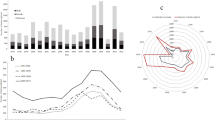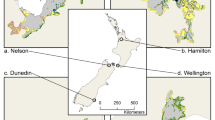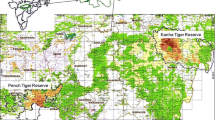Abstract
Central to appropriate wildlife management is an effective monitoring program. Monitoring wildlife in urban environments offers unique challenges in the form of barriers, prohibited access and crime. It also, however, provides a unique opportunity to enlist residential communities in collecting data on distribution of a number of species. Opportunistic sightings data has its flaws, including the lack of data on species absences, and unequal sampling effort. Yet these data may still provide reliable information on the distribution of species and complement localized, hypothesis driven research. Where possible opportunistic sightings data should be validated against traditional methods to determine their value for long term monitoring programmes. We use Maxent to model citizen-reported sightings to determine whether sightings of Cape clawless otters (Aonyx capensis) can complement standardized river occupancy surveys to monitor an elusive, widely distributed species living within a fragmented urban/natural matrix. The drivers of otter presence and the predicted distribution of otters modelled from citizen sightings mirrored that provided by previously published results based on occupancy models in the same system, and highlighted further areas of suitable otter habitat and routes for dispersal. Involving citizens in the monitoring of the urban otter population complemented standardized occupancy surveys and provided additional benefits. In addition to alleviating the pressure on local authorities to allocate resources to routine monitoring, citizen involvement provides an opportunity to gather supplementary data on behaviour and/or threats to the species; shed light on the potential dispersal routes, and promote awareness and encourage coexistence with urban adapted wildlife.





Similar content being viewed by others
References
Akpona H, Reed-Smith J, Yoxon G (2015a) Capacity building to conserve African otters. Oryx 50:15–16
Akpona H, Djagoun CAM, Harrington L, Kabre A, Mensah G, Sinsin B (2015b) Conflict between spotted-necked otters and fishermen in Hlan River, Benin. J Nat Conserv 27:63–71
Black JM (2009) River Otter monitoring by citizen science volunteers in Northern California: social groups and litter size author ( s ): Jeffrey M . Black Source : Northwestern Naturalist , vol 90, no 2 (Autumn, 2009), pp 130–135 Published by: Society for Nor 90,pp 130–135
Bonney R, Cooper CB, Dickinson J, Kelling S, Phillips T, Rosenberg KV, Shirk J (2009) Citizen science: a developing tool for expanding science knowledge and scientific literacy. Bioscience 59:977–984
Bonney R, Shirk JL, Phillips TB, Wiggins A, Ballard HL, Miller-Rushing AJ, Parrish JK (2014) Citizen science: next steps for citizen science. Science (80-. ) 343:1436–1437
Bonter DN, Zuckerberg B, Dickinson JL (2009) Invasive birds in a novel landscape: Habitat associations and effects on established species. Ecography 33(3):494-502
Bouley P, Isadore M, Carroll T (2015) Return of North American River Otters, Lontra canadensis, to coastal habitats of the San Francisco Bay Area, California. Northwest Nat 96:1–12
Brambilla M, Saporetti F (2014) Modelling distribution of habitats required for different uses by the same species: implications for conservation at the regional scale. Biol Conserv 174:39–46
Broman DJ a, Litvaitis J a, Ellingwood M, Tate P, Reed GC (2014) Modeling bobcat Lynx rufus habitat associations using telemetry locations and citizen-scientist observations: are the results comparable? Wildl Biol 20:229–237
Brown CA, Magoba RN (eds) (2008) Cape Town’s rivers and wetlands. Caring for our rich aquatic heritage. Water Research Commission Publication, Pretoria, pp 399
City of Cape Town (2012) Spatial Development plans and Environmental Managememy Framework: Technical Report. City of Cape Town, South Africa.
CSIR (2010) A CSIR perspective on water in South Africa – 2010 (No. Report No. CSIR/NRE/PW/IR/2011/0012/A). Centre for Scientifc and Industrial Research, Pretoria
Danielsen F, Burgess ND, Balmford A (2005) Monitoring matters: Examining the potential of locally-based approaches. Biodiversity Conservation 14(11):2507–2542
Davison A, Marshak M (2012) State of the environment report 2012. City of Cape Town
Dickinson JL, Zuckerberg B, Bonter DN (2010) Citizen science as an ecological research tool: challenges and benefits. Annu Rev Ecol Syst 41:149–172
Dickinson JL, Shirk J, Bonter D, Bonney R, Crain RL, Martin J, Phillips T, Purcell K (2012) The current state of citizen science as a tool for ecological research and public engagement. Front Ecol Environ 10:291–297
Elith J, Phillips SJ, Hastie T, Dudík M, Chee YE, Yates CJ (2011) A statistical explanation of MaxEnt for ecologists. Divers Distrib 17:43–57
Espinosa S, Jacobson SK (2012) Human-wildlife conflict and environmental education: evaluating a community program to protect the Andean bear in Ecuador. J Environ Educ 43:55–65
Follett R, Strezov V (2015) An analysis of citizen science based research: usage and publication patterns. PLoS One 10:1–14
Gibbs JP, Snell HL, Causton CE (1999) Effective monitoring for adaptive wildlife management: Lessons from the Galápagos Islands. The Journal of Wildlife Management 63(4):1055-1065
Gormley AM, Forsyth DM, Griffioen P, Lindeman M, Ramsey DSL, Scroggie MP, Woodford L (2011) Using presence-only and presence-absence data to estimate the current and potential distributions of established invasive species. J Appl Ecol 48:25–34
Higby LK, Stafford R, Bertulli CG (2012) An evaluation of ad hoc presence-only data in explaining patterns of distribution: cetacean sightings from whale-watching vessels. International Journal of Zoology 2012:5
Jackson MM, Gergel SE, Martin K (2015) Citizen science and field survey observations provide comparable results for mapping Vancouver Island White-tailed Ptarmigan (Lagopus leucura saxatilis) distributions. Biol Conserv 181:162–172
Jacques H, Reed-Smith J, Somers M (2015) Aonyx capensis, African Clawless Otter. IUCN Red List Threat. Species 8235
Jaine FRA, Couturier LIE, Weeks SJ, Townsend KA, Bennett MB, Fiora K, et al. (2012) When Giants Turn Up: Sighting trends, environmental influences and habitat use of the Manta Ray Manta alfredi at a coral reef. PLoS ONE 7(10).
Jones JPG (2011) Monitoring species abundance and distribution at the landscape scale. J Appl Ecol 48:9–13
Jordaan RK, Mcintyre T, Somers MJ, Bester MN (2015) An assessment of spatial and temporal variation in the diet of Cape clawless otters (Aonyx capensis) in marine environments. Afr J Wildl Res 45:342–353
Lariviere S (2001) Aonyx capensis. Mamm Species 1–6
Lesmeister DB, Nielsen CK (2011) Protocol for large-scale monitoring of riparian mammals. Wildl Biol Pract 7:55–70
Lindenmayer DB, Likens GE (2010) The science and application of ecological monitoring. Biol Conserv 143:1317–1328
McKelvey KS, Aubry KB, Schwartz MK (2008) Using anecdotal occurrence data for rare or elusive species: the illusion of reality and a call for evidentiary standards. Bioscience 58:549–555
Merow C, Smith MJ, Silander J a (2013) A practical guide to MaxEnt for modeling species’ distributions: what it does, and why inputs and settings matter. Ecography (Cop) 36:1058–1069
Nel JAJ, Somers MJ (2007) Distribution and habitat choice of cape clawless otters, in South Africa. S Afr J Wildl Res. https://doi.org/10.3957/0379-4369-37.1.61
Nel JL, Roux DJ, Maree G, Kleynhans CJ, Moolman J, Reyers B, Rouget M, Cowling RM (2007) Rivers in peril inside and outside protected areas: a systematic approach to conservation assessment of river ecosystems. Divers Distrib 13:341–352
Okes N (2017) Conservation ecology of the Cape clawless otter, Aonyx capensis, in an urban environment. University of Cape Town
Okes N, O'Riain MJ (2017) Otter occupancy in the cape peninsula: estimating the probability of river habitat use by cape clawless otters, Aonyx capensis, across a gradient of human influence. Aquat Conserv Mar Freshwat Ecosyst 27:706–716
Palma L, Beja P, Rodrigues M (1999) The use of sighting data to analyse Iberian lynx habitat and distribution. J Appl Ecol 36:812–824
Pearson RG, Raxworthy CJ, Nakamura M, Townsend Peterson A (2007) Predicting species distributions from small numbers of occurrence records: a test case using cryptic geckos in Madagascar. J Biogeogr 34:102–117
Phillips SJ, Dudík M (2008) Modeling of species distribution with Maxent: new extensions and a comprehensive evalutation. Ecograpy 31:161–175
Phillips S, Anderson RP, Schapire RE (2006) Maximum entropy modeling of species geographic distributions. Ecol Model 190:231–259
River Health Programme (2005) State of rivers report: greater Cape town’s rivers. Department of Water Affairs and Forestry, Pretoria
Rondinini C, Wilson KA, Boitani L, Grantham H, Possingham HP (2006) Tradeoffs of different types of species occurrence data for use in systematic conservation planning. Ecol Lett 9:1136–1145
Rowe-Rowe DT (1995) Distribution and status of African otters. Habitat 11:8–10
Savage M, Klingel J (2015) Citizen monitoring after an otter restoration (Lontra canadensis) in New Mexico, USA 32, 21–24
Swanepoel LH, Lindsey P, Somers MJ, van Hoven W, Dalerum F (2013) Extent and fragmentation of suitable leopard habitat in South Africa. Anim Conserv 16:41–50
Van Strien AJ, Van Swaay CAM, Termaat T (2013) Opportunistic citizen science data of animal species produce reliable estimates of distribution trends if analysed with occupancy models. J Appl Ecol 50:1450–1458
Watson LH, Lang AJ (2003) Diet of Cape clawless otters in Groenvlei Lake, South Africa. S Afr J Wildl Res 33:135–137
White S, O’Neill D, O’Meara DB, Shores C, O’Reilly C, Harrington AP, Weyman G, Sleeman DP (2013) A non-invasive genetic survey of otters (Lutra lutra) in an urban environment: a pilot study with citizen scientists. IUCN/SCC Otter Spec Gr Bull 30, 103–111
Yoccoz NG, Nichols JD, Boulinier T (2001) Monitoring of biological diversity in space and time. Trends Ecol Evol 16:446–453
Author information
Authors and Affiliations
Corresponding author
Rights and permissions
About this article
Cite this article
Okes, N.C., O’Riain, M.J. Can opportunistic citizen sightings assist in the monitoring of an elusive, crepuscular mammal in an urban environment?. Urban Ecosyst 22, 483–492 (2019). https://doi.org/10.1007/s11252-019-0829-3
Published:
Issue Date:
DOI: https://doi.org/10.1007/s11252-019-0829-3




